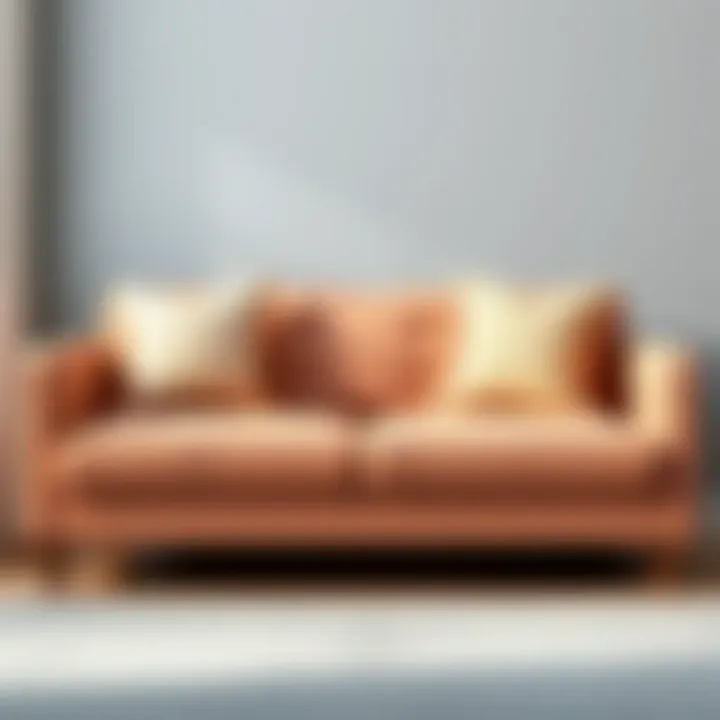Choosing the Right Sofa: Futons, Sleeper Couches, and More


Intro
When it comes to creating a cozy and functional living space, sofas play a pivotal role in setting the stage for both comfort and style. The world of sofas can be more intricate than one might assume, especially with the variety of options available today. From futons that effortlessly transform from seating to sleeping surfaces, to sleeper couches that seamlessly blend aesthetics with functionality, and convertible beds that offer a unique solution for small spaces, understanding these choices can empower homeowners and designers alike. Exploring the differences, benefits, and ideal scenarios for each option will not only enrich interior design choices but also help tailor living environments to suit individual needs and preferences.
Furniture Design Insights
Designing a living space goes beyond aesthetics; it’s about creating an environment that serves its purpose effectively. In this realm, furniture choices must reflect style preferences and spatial considerations.
Understanding Style Preferences
Various sofa types can cater to different design philosophies. For instance, a minimalistic studio may benefit from a sleek, modern futon that doesn't overwhelm the space. In contrast, a family home might lean towards a cozy, plush sleeper couch that welcomes guests while doubling as a sleeping area during gatherings. It’s essential to consider how the sofa marries with other elements in the room:
- Futons are often versatile and can fit into a simpler, more casual aesthetic.
- Sleeper couches typically bring in a touch of elegance and are available in various styles, from contemporary to classic.
- Convertible beds stand as a testament to ingenuity, catering perfectly to small spaces without sacrificing comfort or design.
Maximizing Space with Smart Layouts
Smart usage of space becomes vital, especially in smaller living quarters. Organizing a room around a sofa demands foresight. Here are some tips to consider:
- Position sofas against walls to create a more open feel.
- Use area rugs to define spaces in larger rooms.
- Consider sectional sofas that can be configured in different ways to suit the layout.
"Maximizing your space is the name of the game in effective interior design—it’s about finding the balance between functional and aesthetic."
Maintenance and Care Tips
Investing in quality furniture means taking steps to ensure longevity. Each sofa type comes with its own sets of care requirements to preserve its beauty and functionality.
Cleaning Techniques for Different Materials
Each sofa material—be it fabric, leather, or synthetic—has its unique cleaning needs. Here are some guidelines:
- Fabric sofas should be vacuumed regularly. Spills can be spot cleaned with a damp cloth and a bit of soap.
- Leather couches require conditioning with a suitable cream to prevent cracking; it's wise to clean them with a mild detergent and water mixture periodically.
- Synthetic upholstery can often be wiped down easily, making it a breeze to maintain.
Preventative Measures Against Wear and Tear
To prolong the lifespan of your sofa, follow these tips:
- Rotate cushions regularly to prevent uneven wear.
- Avoid placing your sofa in direct sunlight to minimize fading.
- Use throws or covers if your sofa is frequently used, as an extra layer of protection.
Understanding the intricacies of different sofa types allows for better-informed decisions tailored to unique spaces. The journey to finding the perfect sofa involves a mix of style, comfort, and practicality; once you’ve mastered these nuances, your living space will not only be beautiful but also functional and warm.
Prolusion to Sofa Varieties
Sofas are much more than just a piece of furniture; they represent comfort, style, and the heart of any living space. When it comes to choosing the right sofa, understanding the varieties available can greatly enhance both functionality and aesthetics within your home. This section aims to illuminate the nuances behind different sofa types, particularly futons, sleeper couches, and convertible beds. By exploring these categories, you enable yourself to make an informed decision that fits your unique needs and space constraints.
Defining Sofas, Futons, and Sleeper Couches
Every type of sofa serves a unique purpose, yet they all aim to provide comfort and utility. Sofas, often the centerpiece in a lounge area, blend style with ample seating options. They often come in various designs, ranging from traditional to modern, and can feature intricate upholstery patterns or sleek, minimalist lines.
Futons stem from Japanese origins, where simplicity and practice underpin their design. A futon is essentially a mattress that can be folded and stored away, meaning it serves multiple purposes. Its versatility makes it an excellent choice for smaller spaces or multi-functional rooms.
On the other hand, sleeper couches take the concept a step further. They are designed to transform from a couch into a bed, offering a solution for accommodating overnight guests without the need for a dedicated guest room. The mechanisms used in these couches have evolved significantly, boasting improved comfort and ease of use compared to older models.
In summary, while the basic definitions may be straightforward, the subtleties of each type provide a rich ground for customization and personal preference, allowing homeowners to select options based on their lifestyle and space needs.
The Evolution of Convertible Furniture
The landscape of furniture design has changed dramatically over the decades, especially with the rise of convertible furniture. Originally, simple design principles guided the creation of these items, as seen in traditional futons. There was a time when convertible options were primarily focused on functionality, often sacrificing style in the process.
Today, however, the market is flooded with innovative designs that seamlessly blend functionality with aesthetic appeal. The driv to maximize space in urban settings has led designers to rethink how furniture can serve double duty without compromising on style. This evolution reflects a broader trend towards minimalism and multi-functionality in home design.
The result? Furniture like sleeper couches now features sleek designs and comfortable mattresses that rival those found in dedicated beds. Respecting the growing need for adaptability in living spaces, manufacturers have prioritized not just the usability but also the visual appeal of their products.
"In a world where space often comes at a premium, convertible furniture transforms everyday living while maintaining a critical sense of style."
With these advances, today's consumers can choose from an array of options that speak to both their aesthetic desires and practical needs.
As you delve deeper into this article, expect to learn more about the specific characteristics of each type of sofa, as well as tips on how to select the right piece for your particular needs.
Understanding Futons


Futons have carved a significant niche in the realm of multi-functional furniture. Understanding what these pieces bring to the table is vital for anyone keen on maximizing furniture efficiency in their home. This section will dissect the characteristics, usability, and overall advantages futons present, especially in smaller spaces where practicality meets aesthetic appeal.
Historical Context of Futons
The history of futons traces back to Japan, where they originated as a simple mattress designed for a good night's sleep on the floor. Traditionally filled with cotton, these futons would be air-dried each morning, transforming the living space for daily activities. This versatile approach to bedding wasn't just about convenience; it underscored a minimalist lifestyle that emphasized the use of compact, functional items.
Futons made their foray into Western culture during the 20th century and have evolved from basic mattress-style designs into more diverse forms that incorporate frames and adjustable features. The American version of the futon, often set on a wooden or metal frame, offers an additional layer of practicality, functioning as both a couch and a bed.
Utilizing futons today signifies a blend of comfort, history, and modern convenience, making them a popular choice for urban dwellers, students, and anyone looking to optimize their living area.
Design Features and Variants
When it comes to design, futons come in a wide array of styles, each tailored to meld with different home aesthetics. A futon typically consists of three main components: the mattress, the frame, and the covering. Here are some notable features:
- Frame Styles: From sleek, modern metal frames to rustic wooden designs, these components cater to various décor preferences.
- Mattress Options: The core of a futon is its mattress, available in numerous materials such as memory foam, innerspring, and cotton. Each option offers different levels of support and comfort, catering to varying user needs.
- Coverings: The fabric covering can range widely—from traditional cotton to sophisticated microfibers, ensuring there's something suited for any taste.
Moreover, futons can be customized to suit the user’s preference, allowing for personalization that enhances both comfort and style.
Comfort and Usability Considerations
Comfort is key when considering furnishing options, and futons do not fall short in this regard. The usability of these pieces is a topic worth exploring:
- Versatile Functions: Futons shift seamlessly between being a sofa and a bed, which is especially useful in small apartments where every square foot counts.
- Adjustable Positions: Modern futons often come with multi-position reclining mechanisms, which can ensure optimal comfort whether you're lounging during the day or sleeping at night.
- Space Efficiency: Their compact nature means they fit snugly in tight spaces, making them an invaluable asset for studio apartments or guest rooms.
In terms of usability, lots of users find futons to be durable and easy to maintain, offering a practical solution without sacrificing style. The ease of converting them from a sofa to a bed also speaks to their ascendance in modern, space-conscious living.
"Futons represent not just a piece of furniture but a lifestyle choice centered around versatility and efficient use of space."
In summary, understanding futons allows homeowners, designers, and anyone interested in enhancing their living areas to appreciate how these multifaceted pieces fit seamlessly into modern lifestyles. Overall, they serve as an impressive example of how functional design can enrich one’s living experience while maintaining a nod to historical roots.
Sleeper Couches: A Space-Saving Solution
In an age where urban living is becoming more compact, the need for efficient space utilization continues to grow. As a result, sleeper couches have risen in popularity, providing a practical solution to make the most of smaller living areas. With this dual functionality, these versatile pieces of furniture enable homeowners to not only furnish their spaces stylishly but also create opportunities for overnight guests without the hassle.
Mechanisms Behind Sleeper Couches
The mechanics of sleeper couches can be as diverse as their design. At their core, they feature a folding frame which allows the sofa to transform into a bed. There are few main types. The most popular is the pull-out mechanism, where the mattress is rolled or folded inside the couch and can simply be pulled out. Another design is the click-clack mechanism, which doesn’t require any heavy lifting. By just clicking the backrest, it folds down to reveal the sleeping surface.
- Pull-Out Couch: Takes a bit more effort to set up but usually offers a more comfortable mattress.
- Click-Clack Couch: Easier for quick conversions, ideal for casual use or smaller spaces.
Understanding these mechanisms can heavily influence your decision, especially if you anticipate frequent use of the bed function.
Types of Mattress Options Available
When selecting a sleeper couch, the mattress option plays a significant role in determining comfort levels. Common mattress choices include:
- Innerspring Mattresses: Best for individuals who prefer traditional bed feel. Offers good support but can be bulky.
- Memory Foam Mattresses: Popular for their contouring abilities, helping to relieve pressure points. However, they may retain heat.
- Air Mattresses: Provides customizable firmness, yet their durability can be a concern.
- Hybrid Mattresses: Combine elements of innerspring and foam for balanced comfort, gaining traction among consumers.
By considering the mattress type, you’ll ensure that guests get a good night’s sleep. Remember, not all mattresses fit all couches, so double-check compatibility.
Durability and Maintenance of Sleeper Couches
Durability and maintenance are critical components when choosing a sleeper couch.
First, consider the frame material. A sturdy construction, often out of hardwood or metal, can withstand the wear and tear of daily use. Sofa fabrics also make a difference in longevity. For instance, synthetic fabrics usually hold up better than natural ones, and leather adds significant style but may require more care.
Regular maintenance includes:
- Vacuuming: Regularly helps to remove dust and debris.
- Spot Cleaning: Essential for small mishaps; know your fabric care guidelines.
- Rotation: If possible, rotate the mattress periodically to prevent uneven wear.
By keeping durability and maintenance options in mind, you can select a sleeper couch that not only meets your needs but also stands the test of time, keeping your living space functional and welcoming.
A well-chosen sleeper couch can be a cornerstone of a stylish, practical home, serving both owners and guests effortlessly.
Examining Convertible Beds
Convertible beds, often seen as the chameleons of the furniture world, embody versatility and practicality. These multipurpose pieces hold the potential to enhance space in various living environments, making them a popular choice for urban dwellers. As we dissect this category, we uncover the pivotal role these beds play in modern interior design and the numerous benefits they bring to homeowners and designers alike.
Innovative Designs of Convertible Beds
When speaking of convertible beds, it’s impossible to overlook their innovative designs, which continually evolve to meet changing demands. From wall beds that fold away into sleek cabinets to sofa beds that morph into comfortable sleeping arrangements at a moment’s notice, creativity runs rampant in this arena.


You might encounter convertible beds integrating smart technology, featuring mechanisms that allow for easy conversion without any heavy lifting.
Some notable designs include:
- Murphy Beds: These beds, named after their inventor, can seamlessly fold into the wall, providing an unobtrusive look during the day while ensuring a restful sleep at night.
- Sleeper Sofas: A staple in contemporary living rooms, sleeper sofas blend couch aesthetics with functional sleeping space, offering dual uses without taking up extra room.
- Trundle Beds: Designed to maximize guest accommodations, trundle beds sit beneath another bed, allowing for additional sleeping space without occupying precious floor area.
These designs not only improve space utilization but also add a touch of elegance, showcasing how functionality can intertwine with style.
User Experience and Comfort
Comfort is king, even when it comes to multi-functional furniture. A convertible bed should never compromise on the quality of sleep or relaxation. Newer models are focusing on ergonomics, ensuring that whether it’s a late-night movie on the couch or an overnight guest, comfort prevails.
Think about the details; memory foam mattresses are increasingly common in sleeper sofas, mitigating the hard and lumpy feel often associated with pull-out styles from days gone by. Bed designs that prioritize supportive sleep surfaces can transform the user experience, shifting perceptions about convertible beds.
In addition, features like adjustable firmness level—manageable via remote control or apps—are making their way into the market, catering to individual preferences. Finally, one must also consider materials; fabrics that are both breathable and soft to touch are vital components to a complete user experience.
Space Optimization Benefits
In smaller living environments, maximizing utility without cramping style becomes an art form. Convertible beds rise to this challenge with aplomb, providing solutions that free up floor space while fulfilling multiple functions.
A couple of key benefits include:
- Flexible Layouts: By incorporating a convertible bed, you can reconfigure a room based on its intended use. For instance, a guest bedroom can double as a home office when the bed is stowed away.
- Cost-Effectiveness: Instead of investing in separate furniture for every function—namely a bed and a sofa—converting pieces provide an economical alternative, especially in tight budgets.
- Aesthetic Harmony: Choosing a convertible design means blending two essential elements (comfort and style) while maintaining a harmonious look throughout your living spaces.
"The true beauty of convertible furniture lies in its ability to transform spaces and support lifestyles without compromising style or function."
With the rise of urban living and smaller homes, examining the benefits primary to convertible beds paves the way for smarter designs that cater to modern needs and environments.
Selecting the Right Option for Your Space
Choosing the right sofa involves more than just picking a trendy design or a pretty color. It’s quite a puzzle, really. When factoring in your space, personal needs, and, let’s face it, the lifestyle you lead, the right option can transform your living area from chaotic to cozy. Comfort and functionality together can make or break a purchase, particularly in smaller homes or apartments where every square foot counts.
The available features and layout of your home tremendously influences the decision. An oversized sleeper couch might look divine, but if the room is cramped, those extra inches could become a nightmare. Pay close attention to dimensions and make some real measurements. Getting the right fit ensures not only aesthetics but also usability.
Beyond size, consider your specific needs. Are frequent guests a given? Or do you need a versatile piece for occasional overnight stays? These factors can greatly affect your choice — it’s crucial to align your sofa with your lifestyle, rather than forcing your space to accommodate an unsuitable option.
The difference between a good design and a bad one often lies in how it meets the specific needs of the user.
Assessing Your Space and Needs
To start, take stock of what you’ve got going on. Maybe it's a tiny flat with lots of charm but limited space, or a sprawling living room waiting for the perfect centerpiece. Knowing your constraints helps you determine whether a futon, sleeper couch, or convertible bed aligns best with your environment.
- Measure the Space: Grab a tape measure and jot down dimensions of your intended sofa area. Don’t forget to consider doorways and pathways — a beautiful couch won’t do much good if it can’t fit through the door.
- Evaluate Layout: Analyze the foot traffic patterns. An inviting setup encourages movement and conversation, while a cluttered space leaves people dodging furniture like it's an obstacle course.
- Consider Permanent Vs Temporary Needs: Are you hosting guests for a weekend or living with roommates for years? This will help you decide between a traditional sofa or a more flexible, multifunctional option.
Lifestyle Considerations and Audience Preferences
The type of sofa you choose should reflect your habits and lifestyle. Such choices may also influence not just your daily life but also how you entertain guests.
- Family Life: If you have little ones darting around, a durable fabric or leather option might serve you well. Plus, a sectional might allow for ample room when family gathers.
- Minimalistic Approach: Preference for clean lines and simplicity typically draws one toward sleek convertible beds or modern futons. Those options can cater well to minimalists while providing necessary function.
- Decorative Trends: Keep an eye on the current trends. Right now, earthy tones and sustainable materials are all the rage. This doesn't just matter for aesthetics; it reflects the values of many consumers today.
- Guest Dynamics: If you frequently host visitors, choose a piece that offers comfort and style to those who will be using it overnight.
In the end, the right sofa is out there, waiting to bring your space to life. The essence lies not only in its design or fabrication but also in how well it resonates with your personal needs and lifestyle.
Material Choices and Their Impact
In the realm of convertible furniture, the choices made regarding materials can significantly influence both functionality and aesthetic appeal. Homeowners and designers must consider several elements when selecting upholstery for sofas, futons, sleeper couches, and convertible beds. The right material not only enhances the comfort and look of the furniture but also affects durability, maintenance needs, and even the environmental footprint of the pieces.
Fabric vs. Leather Upholstery
When it comes to the ongoing debate between fabric and leather upholstery, the decision often boils down to personal preferences, lifestyle, and intended use.
Fabric upholstery tends to offer a greater variety of colors and patterns, giving homeowners more creative freedom and the chance to match their existing decor. It's usually softer and warmer to the touch, creating a cozy atmosphere in the living space. Additionally, fabric can be less expensive compared to leather, making it a popular choice for those on a budget or for families with young children, given that stains and spills can be treated more readily.
On the flip side, leather upholstery brings a touch of luxury and sophistication that’s hard to replicate with fabric. Its inherent durability means that leather can withstand wear and tear better, provided one invests in quality materials. It is also easier to clean, making leather a practical option for households where spills and messes are common. However, leather can be sensitive to temperature changes; for instance, it might become too hot in the summer or too cold in the winter. Thus, careful consideration of climate and living situations is essential.
Sustainability in Upholstery Materials
In today’s world, the push for sustainability has gained tremendous momentum. Choosing eco-friendly materials is no longer just a trend—it's become a necessity for many. Homeowners are increasingly seeking out sustainable upholstery options that not only minimize environmental impact but also promote healthier living spaces.
Eco-friendly fabrics can range from organic cotton to recycled polyester that utilizes plastic waste, reducing landfill overflow. Natural materials like bamboo and hemp are gaining traction too, recognized for their rapid renewability and minimal chemical use during production.


Sustainability matters—beyond personal preference, it contributes to a larger effort for a greener planet. By opting for sustainable upholstery, homeowners play a part in a global movement towards responsible consumption.
In contrast, some leather products, particularly those treated with harsh chemicals, can have detrimental effects on the environment. Thus, if leather is the preferred choice, seeking out brands that utilize environmentally friendly tanning processes or ethical sourcing is crucial. Designers can guide clients towards manufacturers that prioritize sustainability and transparency, ensuring that their furniture choices do not compromise the health of the planet.
Ultimately, the impact of material choice extends beyond aesthetics and comfort. It’s about harmonizing personal style with environmental responsibility and functionality. As these considerations come into play, the options available for sofas, futons, sleeper couches, and convertible beds also expand, facilitating the creation of beautiful, sustainable living spaces.
For further details on sustainable materials, visit Wiki's resources on Sustainability and discover various innovative approaches to eco-friendly materials.
Design Trends in Convertible Furniture
In the ever-evolving world of interior design, the role of convertible furniture has become increasingly significant. Both practical and visually appealing, this type of furniture caters to modern lifestyles that demand flexibility. With urban living spaces shrinking and the need for adaptability on the rise, designers are meeting the challenge by creating innovative convertible furniture that balances function and style seamlessly. Recognizing the importance of these trends not only empowers homeowners but also informs retailers and designers looking to stay ahead.
Contemporary Styles and Aesthetics
When we talk about contemporary styles in convertible furniture, it’s crucial to highlight how visual appeal influences buyer decisions. Sleek lines, minimalist designs, and clever use of materials dominate the market, forming a visual language that effortlessly integrates into various home aesthetics. Among the popular choices, you can find:
- Mid-Century Modern: Characterized by organic shapes and a mix of traditional and non-traditional materials, this style offers a vintage feel while maximizing functionality.
- Scandinavian Influence: Clean, simplistic designs focus on light and neutral colors. Futons and sleeper couches in this style often showcase wood accents and natural fabrics, promoting a cozy environment.
- Industrial Elements: This trend incorporates metal frames and reclaimed woods, appealing to urban dwellers seeking a raw and rustic look.
The right sofa not only serves its primary function but can also elevate a room’s aesthetic, contributing to a cohesive design narrative. Homeowners today are looking for statement pieces that echo their identity; hence the demand for convertible furniture with striking designs continues to surge.
Timeless Designs vs. Modern Innovations
Navigating through the landscape of convertible furniture reveals a fascinating dialogue between timeless designs and modern innovations. Although current trends usher in fresh styles, classic elements still hold substantial weight in consumers’ choices.
Timeless Designs often embody tried-and-true principles of comfort and durability. For instance, the classic Chesterfield sofa remains an enduring favorite; combining elegance and versatility, it often adapts into a sleeper option without losing its fundamental charm. These designs have the advantage of flexibility, as they can blend effortlessly into various decors.
In contrast, Modern Innovations showcase a leap in technology and materials. Furniture designers are experimenting with modular systems that allow users to customize their layouts. Sofas can morph into sectional designs, ensuring that every nook of a room is utilized efficiently. Furthermore, advances in mattress technology result in lighter, more durable materials that enhance sleeping comfort without sacrificing design.
Ultimately, the blend of timeless and modern aesthetics reflects a complete approach to furniture that feeds into a broader narrative of sustainability and conscious consumerism. As homeowners seek products with meaning, a hybrid of old and new becomes not just a trend but a statement.
"The furniture we choose tells a story about who we are and how we wish to live."
With these evolving trends in convertible furniture, designers, retailers, and homeowners can explore distinct selections thoughtfully. Whether navigating the charm of a classic piece or inviting innovations into their spaces, the conversation surrounding convertible furniture continues to thrive.
For additional insights, check resources like Wikipedia, Britannica for historical overviews, and Reddit communities for contemporary experiences.
Benefits of Multi-Functional Furniture
Multi-functional furniture plays a crucial role in contemporary living, especially as urban spaces become smaller and lifestyles become more fast-paced. In a world where every square foot in your home counts, the ability to maximize space without sacrificing comfort is paramount. Each piece of furniture no longer simply serves a singular purpose; instead, they evolve into versatile items that cater to various needs. This shift in design philosophy speaks volumes about how our lives are changing and the increasing necessity for efficiency and adaptability in our living spaces.
Enhancing Small Living Spaces
Living in a cozy apartment or a compact home can be charming yet challenging. In such environments, choosing furniture that adds utility is not just wise; it's vital. Multi-functional furniture, like sleeper couches or futons, provides the solution to space constraints by serving two or more purposes.
For instance, consider a sleeper couch that transitions from a stylish sofa during the day into a comfortable bed at night. Clearly, this flexibility can make all the difference in a tight living space. To illustrate, here are some examples of how multi-functional pieces can transform small spaces:
- Sofa Beds: During the day they function as seating; at night, they offer a cozy sleeping area.
- Storage Ottomans: These dual-purpose pieces not only provide a place to kick up your feet but can also hold extra blankets and pillows.
- Wall-Mounted Desks: Foldable desks can be hidden away when not in use, keeping your space uncluttered.
By opting for multi-functional furniture, homeowners can ensure they’re not overwhelmingly cluttered while enjoying the benefits of style and practicality.
Adapting to Varying Lifestyle Needs
Life is unpredictable, and our furniture should be capable of adapting to our changing needs. Families grow, children leave the nest, or a couple might decide to embrace a minimalist lifestyle. Whatever the changes, multi-functional furnishings accommodate these transitions seamlessly.
For instance, a futon might start as a guest bed for visiting friends and later transition into a permanent fixture in a child’s room or a small study. The flexibility they provide makes such pieces invaluable. Some aspects to consider include:
- Comfort Level: Keep in mind the level of comfort. Furniture that transforms should not compromise on the quality of sleep or seating.
- Design Aesthetics: Choose styles that enhance or complement the existing decor, rather than clash with it.
- Utility vs. Space: Ensure the furniture serves a practical function without overcrowding the area.
Multi-functional furniture is not merely a trend; it's a necessary evolution for modern living.
As this exploration emphasizes, the benefits of furniture that adapts to various roles cannot be overstated. With careful consideration, designers and homeowners alike can choose wisely, ensuring their spaces remain functional and inviting for years to come.
Ending
As we wrap up this exploration of sofa options, it’s essential to reflect on the nuances that differentiate futons, sleeper couches, and convertible beds. Each of these multi-functional pieces of furniture serves distinct purposes, and their relevance can vary dramatically based on individual lifestyles.
When considering the choice of furniture, several elements come into play. The key factors include comfort, design, usability, and material choice. An astute homeowner, designer, or DIY enthusiast must consider not just aesthetics but also how these options serve their particular needs and living spaces.
Final Thoughts on Sofa Options
In choosing between futons, sleeper couches, and convertible beds, the decision often boils down to maximizing your space without sacrificing style or comfort. For instance, futons often appeal to those aiming for a minimalistic carbon footprint while ensuring functionality. Conversely, sleeper couches strike a balance between form and function, effortlessly transforming guest accommodations into stylish seating areas without excessive bulk.
Furthermore, whether you lean towards a classic design or something modern speaks volumes about personal taste. Many find that the evolution of these furnishings allows them to blend seamlessly into various interior styles—from rustic to contemporay. Ultimately, the goal remains the same: to enhance aesthetic appeal and practicality in home design.
"The right choice of sofa can redefine the atmosphere of a space, turning it from a simple living area into a personalized haven."
In closing, achieving harmony between functionality and style is a journey unique to every homeowner. Whether you’re a professional designer or a practical DIYer, understanding the benefits and drawbacks of each option is paramount. Equip yourself with this knowledge to make informed decisions that cater to your specific living environment, guaranteeing satisfaction for years to come.















